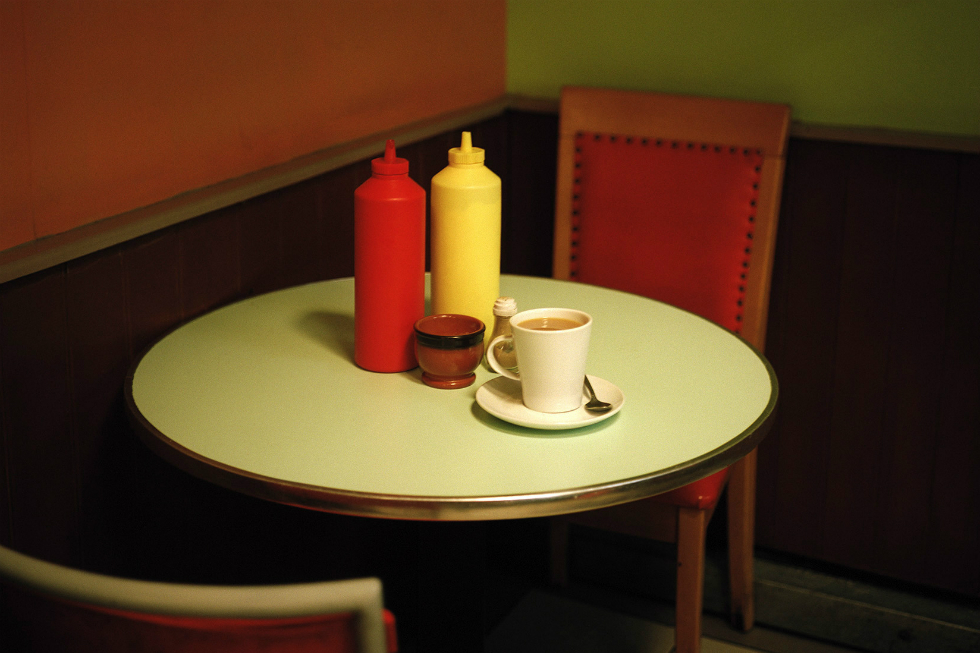Making the Mundane Enigmatic – Niall McDiarmid’s Southwestern

The American Road Trip localised to a small corner of England: Stephen Clarke reflects on photographer Niall McDiarmid’s latest photo book, Southwestern…
In the opening picture (below) of Niall McDiarmid’s book Southwestern, a middle-aged man stands on the pavement outside the closed gates of a car wash in Tooting, London. In the photographed space this figure is too distant to be a portrait in the manner of the photographer’s previous projects. Instead, the man seems to be a part of his surroundings, a resident. There is a suggestion that this is early morning, before the working day starts. He could be waiting for the car wash to open or perhaps he is here to greet the photographer and accompany the viewer of this personal response to the city. McDiarmid settled in London thirty years ago. While he has become familiar with the mundane details of this place, there endures for him a sense of the enigmatic.
McDiarmid’s picturing of a journey begins in a café in Streatham. Condiments sit on shiny-topped tables; rigidly-fixed, vivid-green bucket chairs are vacant. A shaft of sunlight reveals the equally bright green of the grassy foreground of a large painting that hangs on the wall above absent diners. The painted landscape has the appearance of the Scottish Highlands – McDiarmid’s homeland; maybe, past and present subconsciously meet in the photographer’s mind. Poignancy is found in this empty scene, no figure can be seen in the painting, and likewise no body rests in the silent café.

Throughout the book, McDiarmid and the viewer stop off for a bite to eat. In Tooting, a person in a dark blue robe sits with back to us while dining at an eatery; in a Summerstown café, light is cast over a painting that is quintessentially English – Constable Country; one red ketchup bottle and one yellow mustard bottle stand guard on a Lambeth table (top); and breakfast is ablaze in sunny Croydon. Each of these locations shares a stillness that is indicative of the restfulness of the weekends when many of these photographs were taken.
Still life observations punctuate the book, odd and slightly unnerving. At the roadside in Wandsworth, a drinking cup sits on top of a post, half-full with a red straw standing upright: will its owner return or will the balanced cup fall from its pedestal? Through the glass windowpane in Colliers Wood, false teeth are scattered on the floor underneath a spiky cactus; plastic choppers and serrated plant provide minor threat. A yellow-green broom rests against an outside wall in Tooting, beneath its bristles are a scattering of oranges, strawberries and a lemon: is this a new urban game of bat-and-ball?
Photographed interiors provide similar mystery in this book. A reception desk in Mitcham, positioned in a narrow space, is deserted. Another lonely chair, tubular frame with blue upholstery, looks inwards away from the open doorway of a shop in Croydon. Back in Wandsworth, pastel-green watering can, pale blue container, yellow dish-drainer, and orange bucket, sit silently on white shelves in a lean-to. In all of these pictures action is withheld, quiet moments linger.
This quiescent state is alien to the bustling London, where everyone is on the move. In this populous city, criss-crossed by roads and railways, people rush to bus stops and train stations. For his earlier book, Town To Town (RRB, 2018), McDiarmid made good use of the national rail network to transport him across the United Kingdom to photograph people as far apart as Edinburgh and Carlisle, Southampton and Bournemouth, Morecambe and Hull. Returning to London, portraits were also taken nearer to home.
In Southwestern, the viewer is introduced to some of these Londoners: an old lady in Mitcham leans over the sign that names the street; a schoolgirl and schoolboy walk hand-in-hand in Battersea; and the salesman in Tooting raises his arms to reveal multiple wristwatches. On the train at Putney, McDiarmid photographs a passenger reading the newspaper at the start of his day or at the end of a busy day travelling through London.

The image of a compass adorns the back cover of Southwestern; a singular white dot marks the position southwest. Niall McDiarmid has travelled around Britain and so this motif is appropriate, seemingly pointing to a specific location, the south west of London. This is McDiarmid’s conceit – he directs attention not to a simple descriptive title but to one that requires an analogical reading. His intention was to create a frame of mind that takes its cue from the pictures made by American photographers such as William Eggleston and Stephen Shore. In McDiarmid’s pictures, the light and colour of the southwestern States of America are to be found in the gloomier climes of the British capital. In his book, the expansive American Road Trip becomes localised to the exploration of a small corner of England that can be encompassed on foot.
The close of each day is recorded, and darkness intrudes a number of times; this provides opportunity for artificial illumination to shine out emphasising the odd. Empty streets and railway platforms become unfamiliar scenes. The final destination in this book is a level crossing in Barnes. A train hurtles past, visible as a blurred obstacle cutting off two small figures in the foreground from the other side of the track. Beyond is the blackness of the unknown, waiting to engulf the travellers. Our guide leaves us at this juncture.
Stephen Clarke is Lecturer in Critical and Contextual Studies: Art & Design at the University of Chester
All images, from top, © Niall McDiarmid, from the series, Southwestern, 2019: Main, Lambeth (detail); Tooting; Barnes; home page: Barnes (detail)





